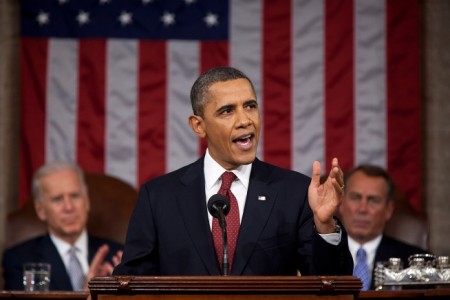In his State of the Union address last month, President Obama said he wasn’t backing down on his commitment to clean energy, and that’s born out in the fiscal year 2013 budget the White House released today. The budget doesn’t shy away from spending on clean energy as the U.S. Department of Energy (DOE) budget grows 3.2 percent to $27.2 billion and spending on clean energy across government agencies rises by 13 percent to $6.7 billion, according to the Office of Management and Budget (OMB).
Of course, any detailing of the president’s budget comes with the caveat, “For what it’s worth.” That’s because everyone in Washington understands that with a Republican-controlled House of Representatives and a determined minority of Republicans in the Senate, whatever spending authorizations ultimately emerge are likely to be the result of election year brinkmanship that sees some programs spared and others jettisoned.

So for what it’s worth: The administration wants to boost funding for ARPA-E, the Advanced Research Projects Agency-Energy, to $350 million. That’s a program devised under the Bush administration that didn’t get funded until the 2009 stimulus and has been fighting for money ever since. After Republican attempts to cut it significantly, it received $275 million for the current fiscal year.
That funding is in the DOE budget, as is $2.3 billion for the Office of Energy Efficiency and Renewable Energy (EERE) “to advance state-of-the-art clean energy technologies.” The EERE budget includes an 80 percent boost in funding for energy efficiency initiatives “that will improve America’s competitiveness and increase our energy productivity, saving consumers and businesses money,” according to the OMB.
The EERE budget also calls for $310 million for the SunShot Initiative, the administration’s program to make solar energy cost-competitive without subsidies by the end of the decade, as well as $95 million for wind energy and $65 million for geothermal energy and enhanced geothermal systems.
But as mentioned, not all the clean energy funding under the Obama plan would go through DOE.
According to Reuters, the budget includes $1 billion for “energy conservation investments in a Department of Defense program,” a big boost from the $400 million spent in 2010. The military has been a growing focus for the administration on the clean energy front, and Reuters said politics could be driving it to turn even harder in that direction. “Including funding for clean energy in the Pentagon’s budget could help shield the administration from Republicans who say the government should not be in the business of picking technologies. Few lawmakers would argue the country does not need to reduce the energy dependency of military aircraft, tanks and ships,” Reuters said.

The president also proposes continuing a policy of aggressively pursuing clean energy development on public land, with $86 million going for review and permitting of such projects. The administration is aiming to permit “at least 11,000 megawatts of new solar, wind, and geothermal electricity generation capacity affecting Department of the Interior-managed lands by the end of calendar year 2013.”
Finally, the president wants to extend the production tax credit for renewable energy—a key priority for wind-power producers—which is due to expire at the end of this calendar year. And he wants to bring back the lapsed Section 1603 Treasury Program, which allowed renewable energy developers to receive a grant for up to 30 percent of the cost of a project in lieu of claiming an energy tax credit until it died at the end of 2011. That won the president a cheer from the Solar Energy Industries Association.
“America’s solar industry appreciates President Obama’s support for extending the 1603 Treasury Program,” Rhone Resch, president and CEO of the SEIA, said in a news release. “The 1603 program has helped leverage over $24 billion in private sector investment in for a wide range of clean energy projects, and extending the 1603 program will create an additional 37,000 jobs in the American solar industry in this year alone. ”